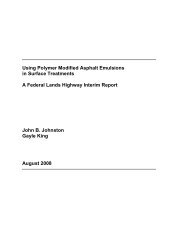Handbook for Bridge Inspections - TSP2
Handbook for Bridge Inspections - TSP2
Handbook for Bridge Inspections - TSP2
Create successful ePaper yourself
Turn your PDF publications into a flip-book with our unique Google optimized e-Paper software.
6.5 Major Inspection of Cables<br />
6.5.1 Objective and Scope<br />
<strong>Inspections</strong> incorporate a visual inspection of the load-bearing<br />
cables, suspension rods and retaining elements so as to ensure<br />
these are fulfi lli ng their funct ion. Where necessary measurements<br />
and examination of materials should be undertaken to supplement<br />
the visual check and act as a basis <strong>for</strong> evaluating possible fu ture<br />
damage and wear. See Table 7. 1-1 and Chapter 7.2<br />
It is recommended that a special inspection is carried out whenever<br />
the main cable inspection reveals the need <strong>for</strong> repairs or this<br />
latter inspection has not been suffic ien tly thorough in order to<br />
determine the kind of damage, its consequences, extent or cause.<br />
Refer to Chapter 6. 7 ~ Special <strong>Inspections</strong>. It should be stated<br />
which measurements! materials inspections are to be carried out,<br />
their scope and location. See Chapter 8.2 <strong>for</strong> submitting the relevant<br />
reports.<br />
6.5.2 Visual <strong>Inspections</strong><br />
Visual inspections should be of the close type as detailed in<br />
Chapter 6.4.2 <strong>for</strong> main inspections.<br />
This involves carrying out a closc visual inspection of all cables<br />
from anchorage to anchorage and around the entire cross-section,<br />
and of both the upper and lower suspension<br />
rods and the suspension rod clamps. In special circumstances this<br />
special requirement can be departed from if one can with certainty<br />
detect anticipated damage from a longer distance. Thi s can be the<br />
case with clearly visible lengths of cable or suspension rods. In<br />
such cases representative sections should be selected fo r closer<br />
visual inspection whi lst the remaining areas can be inspected from<br />
greater distances. C haracteristical ly serious damage should be ill u<br />
strated in photographs or sketches.<br />
Access equipment should be used as required so that one can reach<br />
the prescribed measuring distance. Refer to C hapter 4 .2 - Access<br />
Equipment.<br />
A bridge should be inspected in such a way that a ll its elements are<br />
systematically checked. Cables, anchorages, towers and suspension<br />
rods should be marked with a number which con<strong>for</strong>ms with the<br />
system <strong>for</strong> parts location as detai led in Chapter 2.4.3.<br />
Individual elements are to be checked <strong>for</strong> damage, defects and<br />
fau lts during a visual inspection as listed below. Please refer to<br />
Chapter 9 - Damage Evaluation Catalogue<br />
74<br />
<strong>Handbook</strong> <strong>for</strong> <strong>Bridge</strong> Inspect ions
















